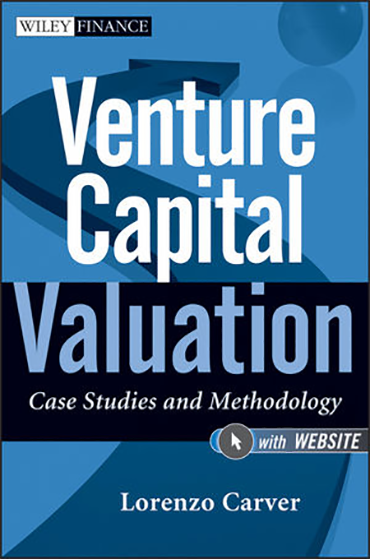Venture Capital Valuation: Case Studies and Methodology
December 2011 Hardcover (288 pages)
Lorenzo Carver
John Wiley & Sons, Inc.
When founders, VCs, angels, attorneys, CFOs, CEOs, and employees don't understand the true meanings of "value" and "valuation," they end up losing money—lots of money. Venture Capital Valuation is for anyone involved in a venture capital- or angel-backed private company who wants to get the most out of their investments by controlling one of the few things they can when dealing with high-velocity, risky investments: their understanding of valuation.
Author Lorenzo Carver shares his decades of experience simplifying the high-growth company valuation process for clients in every business sector. Anchored by scores of high-profile examples, Venture Capital Valuation deftly illustrates how stakeholders in a given startup or high-growth company could have improved their outcomes by having better information about valuation.
Helping readers answer such vital valuation questions as "What's this company worth?" "Is this a fair valuation?" and "Are we leaving too much money on the table?" Venture Capital Valuation dissects the valuation profiles of some of today's leading corporations, including:
-
Facebook
-
Twitter
-
LinkedIn
-
Microsoft
-
Yahoo!
-
Kayak.com
- Zogenix
Plus, it includes interviews with venture-backed company valuation experts Jeff Faust, Josh Cashman, and Joe Orlando. Learn how "value" changes rights to cash flow at every stage of a company's evolution with Venture Capital Valuation.
Table of Contents
Introduction What You Don’t Know About Valuation Will Cost You Money 1
Chapter 1
Using Facebook, Twitter, and LinkedIn to Explain VC Valuation Gains and Losses: How VCs, Angels, Founders, and Employees Give Up Investment Cash Flow Every Day 13
Did Valuation Ignorance Cost ConnectU (and the Winklevosses) $50MM? 14
An Expert Doesn’t Need a 409A Valuation When He or She Has a Certificate and Basic Math 15
Valuing Facebook’s Common Stock Compared to Preferred Stock in Minutes 16
What the Winklevosses Would Have Seen in Any 409A Valuation Report 19
Deriving a Discount for Lack of Marketability for Valuations 27
Facebook at $80 Billion Valuation versus Enron at $80 Billion Valuation 35
Deal Terms, Waterfalls, and the Pre-Money Myth 36
The Pre-Money Myth 44
Summary 56
Chapter 2
Should Venture-Backed Companies Even Consider a DCF Model?: Introducing the Life Science Valuation Case: Zogenix 57
Zogenix: Company Background Summary and Highlights 58
Leaping Forward Just 20 Months, the Company Files for an IPO 64
Order of Valuations Presented in This Case 67
Chapter 3
Valuation Methods versus Allocation Methods Regarding Zogenix 69
Separating Enterprise Value from the Allocation of That Value 69
Valuing Total Equity 72
Using Future Value (FV) and Present Value (PV) to Value Future Cash Flows Today 79
Summary 82
Chapter 4
Applying the Typical DCF Model to a Venture-Backed Company Hardly Ever Works 85
The Gordon Growth Model 85
High Growth Limits the Gordon Growth Model 87
Dividend Irrelevance and Capital Structure Irrelevance 90
Using Comparables (Generally Market Multiples) to Generate a Terminal Value 91
Actual Differences between Angels and VCs versus Perceived Differences 100
Applying Valuation Methods and Allocation Methods at Inception 102
Summary 104
Chapter 5
“Enterprise Value” + “Allocation Methods” = Value Destruction: Undervaluing Companies and Overvaluing Employee Options 107
Most 409A Valuations Undervalue the Company and Simultaneously Overvalue Employee Stock Options 107
Did Auditors Drive Valuators to Overvalue Employee Stock Options? 109
Most 409A Enterprise Value Calculations Ignore the “Takeover” Value of Preferred 113
The Realistic Range of Possibilities Depends on Who the Investors Are 119
Overstating Returns and Understating Returns on the Same Asset (Simultaneously) 125
What Happens to Fund IRRs When You Assume Book Value Equals Market Value? 128
The Real Cost of Fair Value, Fair Market Value, and Enterprise Value 132
Yahoo! Case 137
Chapter 6
Why You Should D.O.W.T. (Doubt) Venture Capital Returns—Option Pool Reserve 159
Unissued Option Pools 159
Value Conclusion Elements Impacted by Option Pool Reserve Assumptions 161
Impact on Parties Relying on Assumptions of VC Investments 176
Chapter 7
If Valuation Can’t Make You Money, Do You Really Need It?: Learning Practical Applications from Kayak.com 183
Applying Studies to Real-World Cases 186
Important Questions to Ask 213
Summary 223
Chapter 8
Don’t Hate the Appraiser (Blame the Auditor Instead) 225
Interview with Jeff Faust, AVA 226
Summary 236
Chapter 9
Don’t Blame the Auditors (Blame the Practice Aid Instead): 409A Valuation Professionals Discussing Topic 820 (FAS 157) with VC CFOs 237
Introduction to the Expert Panelists 238
The Auditor’s Valuation “Bible” 239
SAS101 Tests, PWERMS, and OPMs 240
PWERMS and rNPV/eNPV Models 243
Subjectivity and the PWERM (or “Power”) Method 243
Finding Inputs for the OPM Model 245
Enterprise Values versus Allocations 246
Next Round Pricing and Topic 820 248
Different Ways of Treating Granted, Unvested, and Reserved Options 250
Valuing Warrants in Venture-Backed Companies 252
Quantifying Qualitative Inputs to Value Conclusions for VC-Funded Companies 253
Discounts for Lack of Marketability (DLOM) and Venture-Fund Portfolios 254
Sharespost, SecondMarket as Market Inputs 258
Summary 262
Chapter 10
Now That You Understand Venture Capital Valuation, Share It 263
About the Author 269
Index 271
